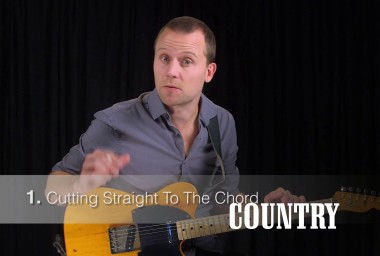Country Style Guitar Course: Level 1
Country music celebrates the beauty of simplicity. In Country Style Course 1 you will learn all the foundational basics needed to become a great country guitarist including basic acoustic strumming, how to make your blues and pentatonic scales sound country and some country fingerpicking techniques. We’ll even go over country guitar gear and tone so you can sound like the pros.
Chapter: 1: The Acoustic Foundation
In this chapter you will build a very basic vocabulary of chords, progressions and strumming patterns on acoustic guitar, which will serve as the foundation throughout the rest of the curriculum.
Introducing common strumming patterns in Country, applied to a one chord groove. Start with all 4, then accent 2 and 4, then add the upstroke so it's "1, 2-and, 3, 4-and".
Published: 09/10/2015 UpgradeIntroducing some of the most common open chords used in country with the basic strumming from the previous tutorial.
Published: 09/10/2015 UpgradeIntroducing the concept of separating the root note and alternating between that and the chord. Applied to all the chords from tutorial 2.
Published: 09/10/2015 UpgradeNow that you know some of the most common chord progressions used in country, it's time to look at some of the most common ways to lead into and out of these progressions or any given chord progression for that matter. In the context of a song this would be called adding "intros" and "outros". There are of course endless variations on each of these examples, but in this tutorial we'll explore the most basic and common versions of intros and outros used in country songs.
Published: 09/10/2015 UpgradeChapter: 2: Electric Rhythm Tools Vol 1.
In this chapter you will learn how the electric guitar might compliment the acoustic rhythm parts they learned in the previous chapter. The acoustic guitar covers the harmony, so electric guitar is more of a rhythm instrument in this context.
Now that you're familiar with the basic foundation that most country songs are built on, which is the acoustic guitar strumming chords, it's time start exploring how an electric guitar might compliment these basic parts. Although the electric and acoustic guitars are similar in many ways, the roles they play within the band are very different. The acoustic guitar covers the basic harmony, so the electric guitar is actually more of a rhythm instrument in this context.
Published: 09/10/2015 UpgradeNow that you're familiar with the most basic application of barre-chords in a Country Context, let's take it one step further by adding the classic root/5 bass movement, just like we did on acoustic guitar earlier.
Published: 09/10/2015 UpgradeIn this tutorial we're going to explore one of the most quintessential electric country rhythm tools. This tool is a rhythmic and percussive approach often referred to as "Tic Toc" guitar parts and I'm sure you'll recognize the sound of it!
Published: 09/10/2015 UpgradeIn this tutorial we'll apply the "Tic Toc" concept to our open chords. This is when it really starts to sound right, but it's also a bit more challenging.
Published: 09/10/2015 UpgradeWhen you play a full barre chord there are actually many more notes than you really need. In this tutorial we'll look at how to strip down your full barre-chords to smaller versions of each chord known as "triads" and how you can use those in your electric country rhythm playing.
Published: 09/10/2015 UpgradeOften in country music the electric guitar will need to fill in for a melody instrument, in place of the pedal steel, or the fiddle, and take the leads for the intros, outros and solos. The electric guitar will use the rhythm tools you've already learned to compliment the harmony and the groove.
Published: 09/10/2015 UpgradeChapter: 3: Country Lead Tools Vol 1.
In this chapter you will learn a basic introduction to country lead playing. You'll learn to use triads and pentatonic scale tricks.
Anders shows how basic triads can be used a basic introduction to playing solos and lead parts in a Country context.
Published: 09/10/2015 UpgradeAnders will explore the top 3 strings of the A major pentatonic scale. He'll use the A major barre chord with the root on the 6th string and make a basic Country lead pattern.
Published: 09/10/2015 UpgradeAnders will show you show to add more flavor to you country lead guitar playing using chromatic notes to the basic pentatonic scales in order to add "tension" or "spice".
Published: 09/10/2015 UpgradeAnders starts exploring the concept of "licks" as a language of musical statements. He takes the ideas learned in previous course tutorials and show you how to use them as the building blocks as a starting point for your own country style improvisation.
Published: 09/10/2015 UpgradeNow it's time to try combining all of these techniques, but in order to avoid overwhelming you with options, we'll explore the different combinations one at a time, before we put it all together at the end.
Published: 09/10/2015 UpgradeChapter: 4: Electric Rhythm Tools Vol 2.
In this chapter you will expand you knowledge and skill in country rhythm playing. You'll add melody lines, chord arpeggiation and pedal steel guitar tricks.
Up until now we've kept rhythm and lead playing very separate, but now that you have a basic understanding of both of these skill sets it's time to start exploring how the two can overlap and work together.
Published: 09/10/2015 UpgradeIn this tutorial we're going to explore how to incorporate more rhythm guitar arpeggios into your country rhythm guitar playing in some fun and useful examples.
Published: 09/10/2015 UpgradeA crucial cornerstone in the classic Country sound is the pedal steel guitar. This is a whole different instrument to play, but in this tutorial we'll look at some simple ways to emulate the sound of a pedal steel guitar on our regular electric guitar.
Published: 09/10/2015 UpgradeWe've already explored some basic of examples of how rhythm and lead playing can sometimes overlap, and now it's time to take that concept one step further by looking at different ways to embellish your basic chords and rhythm parts in a Country context.
Published: 09/10/2015 UpgradeAt this point you've hopefully gotten pretty comfortable with using your pick, but for this tutorial we're going to put it down and instead explore all the sounds we can get out of using our right hand fingers instead.
Published: 09/10/2015 UpgradeChapter: 5: Country Lead Tools Vol 2.
In this chapter you will expand you knowledge in country lead playing. You'll lean approach tones, chicken pickin' licks and double stops. You'll also apply these skills to acoustic guitar!
In this tutorial we'll explore an extremely useful trick that you can use in your lead playing to obtain a slightly jazzier sound. This trick revolves around chord tones and arpeggios and uses the half step below each of these.
Published: 09/10/2015 UpgradeOne of the most common lead tools used in country is called "chicken picking", and it refers to a percussive right hand technique that I'm sure you'll recognize the sound of. It's a really great sound, but it does require a whole new right hand technique where you combine the regular use of your pick with your right hand fingers.
Published: 09/10/2015 UpgradeIn the previous chapter we explored the wonderful world of pedal steel vocabulary on electric guitar. We used the basic vocabulary in more of a rhythm guitar context, so in this tutorial we'll explore that same vocabulary in a lead context. This will once again challenge your bending technique, but it will also open up a whole new world of interesting sounds in your lead playing.
Published: 09/10/2015 UpgradeSo far we've been improvising with a combination of single notes, triads and pedal steel licks, and now it's time to explore another crucial component in the classic country sound. This sound comes from deliberately picking two notes at a time, and the sound is commonly referred to as "double stops".
Published: 09/10/2015 UpgradeSo far we've been using our acoustic guitar as accompaniment and our electric guitar as a combination of accompaniment and lead. But some of the electric tools will work on acoustic as well and that's what we're going to start exploring in this tutorial.
Published: 09/10/2015 UpgradeIn the previous tutorial you got a basic introduction to country lead playing on acoustic guitar. In this tutorial we're going to venture further into this terrain with some more cool licks, tricks and tools.
Published: 09/10/2015 UpgradeChapter: 6: Country Gear and Tone
In this chapter you will learn about the basic gear and tones used in country. You'll learn all about the guitars, amps and effects used to get that twangy country tone!
This tutorial will introduce you to the most common guitars used in Country music: Telecaster, Stratocaster, Hollowbody, Bigsby equipped and acoustic.
Published: 09/10/2015 UpgradeIn this tutorial we'll turn our attention to an actual amp, and we'll break down all the different parts and controls that you find on a classic guitar amp. This will enable you to dial a great Country tone on almost any amp you encounter down the road. We'll use a Fender Super Reverb as the test subject, since it has many of the basic controls you'll find on most amps.
Published: 09/10/2015 UpgradeIn this tutorial we'll explore a very useful effect that you hear all the time in Country music. This effect is called "delay", which is the same thing as an echo effect. The reason it's called "delay" is that the pedal splits up your signal and delays one of them to create the echo effect.
Published: 09/10/2015 UpgradeIn this tutorial we're going to explore some useful effects that I'm sure you'll recognize the sound of when you hear them: the volume pedal, compression, and phaser.
Published: 09/10/2015 Upgrade






























